Early Electricity in the Titanic Memorial Lighthouse
A Collections Chronicles Blog
By Martina Caruso, Director of Collections and Exhibitions
April 10, 2025
Have you ever thought about where your electricity comes from? Whenever you turn on a light or charge your phone, the electricity coming from the outlet may well have traveled hundreds of miles across the power grid that blankets most of North America. New York has a full menu of energy options, as there are hundreds of power plants producing electricity from natural gas, nuclear energy, and hydro energy, to solar and wind power. But where did it all begin? In the Seaport, in the late 19th century!
With this third blog post in a series focused on the restoration of the Titanic Memorial Lighthouse[1] Revisit the first and second blog posts in the series at “Shining a Light on a Unique Public Artifact” and “Time Balls“!, I’m going to explore the lights components, including the creation of the memorial’s really special lights and the history of early electricity in Lower Manhattan.
Electricity in Lower Manhattan
New York’s utilities, like its transport system, have lived above ground and at times below, and with few exceptions, they too dutifully followed the path laid out by the Commissioner’s Plan of 1811.
Gas was the first source of power to be distributed centrally. Dating back to the 1820s, gas companies pursued clients aggressively, until economies of scale drove them together as the Consolidated Gas Company of New York in 1884. By that time, the system of pipes made of iron or steel that ran under the streets, punctuated by emergency valves to control flow, was making its debut.
Steam heat was introduced in the 1880s. For apartment owners and dwellers, the opportunity to get rid of chimneys and reuse existing boiler space in buildings was significant. The payoff for the New York Steam Company, at least in the dense areas of Manhattan South of 96th Street, was equally great on the commercial side: New York’s central steam system found a profitable customer base in hospitals, dry cleaners, cultural institutions, and large office complexes like Rockefeller Center. It remains the largest central steam system in the world.
Electricity would be next, roughly brought in at the same time of steam heat. Electricity cables ultimately stretched above and across city streets—like the one visible here, in this stereograph card from the Museum’s archives, running along South Street—until the massive snows of the blizzard of 1888 led to the placement of telephone, telegraph, and electricity cables underground, accessed primarily by an extensive network of manholes.
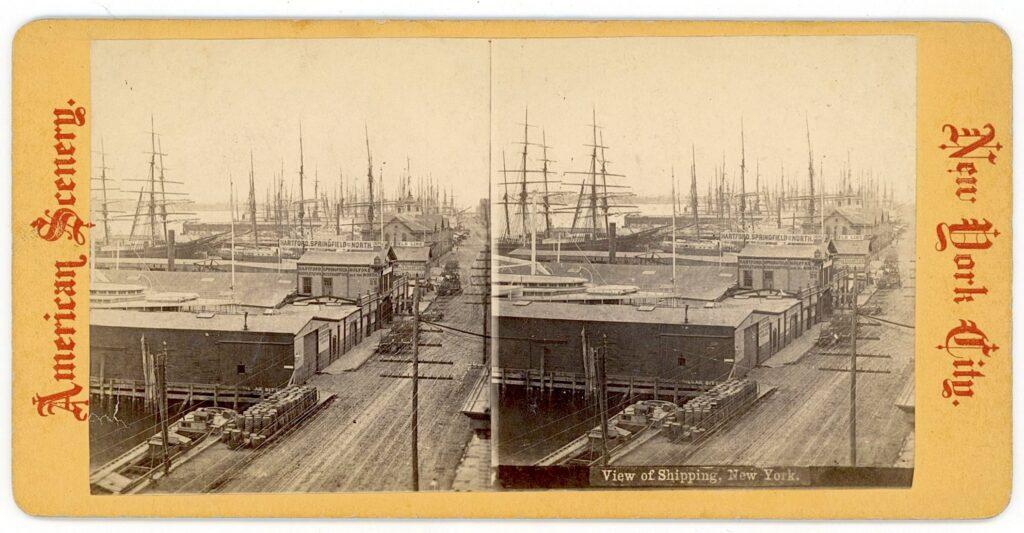
View of Shipping, New York, ca. 1885. South Street Seaport Museum Archives H20-0177
Late-19th-century Americans were fascinated by the promise and mystery of electricity. Electricity had been discovered for some time, though this was the beginning of its practical commercial usage. There was no such thing as an electrical “grid” then—service was limited to a patchwork of power stations serving select parts of a few American cities. Electricity sparked widespread media attention, and was more of a novelty for general consumers as well as some physicians and hospitals, used for things like this Magneto-Electric Machine in the Museum’s collections. Objects also started to become illuminated like this binnacle, which was converted for electric use.



Left: Harper’s Weekly, publisher. “The Electric Light at Sea” August 27, 1881. Gift of Mavis P. Kelsey 1998.007.0813
Center: W.H. Burnap, manufacturer. “Davis & Kidder Patent Magneto-Electric Machine for Nervous Diseases”, 1875-1885. Gift of Arthur D. Steinberg 1981.046.0009
Right: Binnacle Lamp, late 19th century. Seamen’s Bank for Savings Collection 1991.072.0028
The American Electric Age began in New York on September 4, 1882. That day, Thomas Edison’s (1847–1931) Edison Illuminating Company flipped the switch on his power station located at 255-257 Pearl Street in Lower Manhattan, providing electricity to homes at a price comparable to gas. By the end of the month, they had 59 customers. By the following year, they had 513.
“The giant dynamos were started up at 3 o’clock in the afternoon, and according to Mr. Edison, they will go on forever unless stopped by an earthquake. One third of the lower district was lighted up, the territory being within the boundaries of Nassau and Pearl streets and Spruce and Wall Street.”[2]”MISCELLANEOUS CITY NEWS; EDISON’S ELECTRIC LIGHT. “THE TIMES” BUILDING ILLUMINATED BY ELECTRICITY.” September 5, 1882, The New York Times. The offices of The New York Times were among the first to gain access to this new system. They reported that the light was “soft, mellow, grateful to the eye,” as compared to arc lighting, which was the only form of electric lighting before that time[3]The National Museum of American History owns a scale model of Thomas Edison’s Pearl Street power station, made in 1927. It demonstrates the internal arrangement of generating equipment and … Continue reading.
Edison’s system created a demand for energy over greater distances, which was very expensive, making the Pearl Street station a victim of its own success. The public remained unaware that the Pearl Street system was a money-losing business for several years. Its initial cost had been high, and there were ongoing operating expenses, such as the huge amount of coal that had to be fed into the plant’s boilers to generate steam for the dynamos. Pearl Street’s operating expenses were higher than its income in 1882 and 1883. It finally became profitable in 1884.
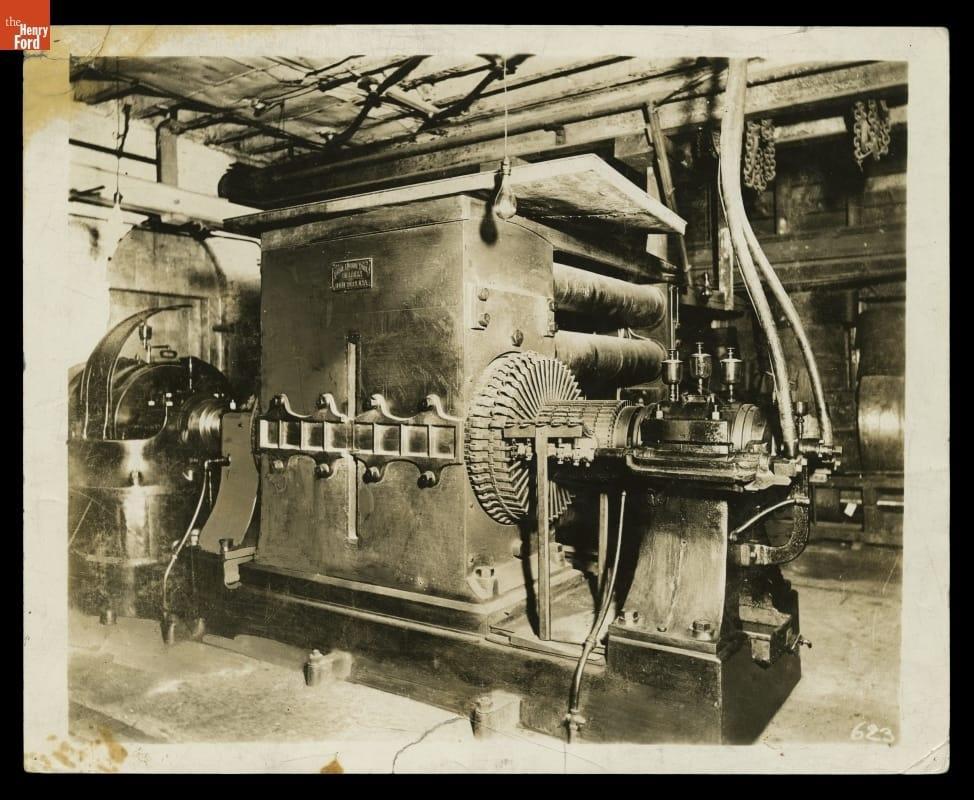
The station operated successfully until a fire broke out on the morning of January 2, 1890[4]The remaining unit from the fire is preserved today at the Henry Ford Museum and Greenfield Village, and was designated a National Historic Mechanical Engineering landmark by the American Society of … Continue reading. The station was rebuilt and continued to operate until 1895, when it was decommissioned. By that time, engineers had designed power plants of much greater size, intended to serve a larger area—Pearl Street had become obsolete. The site of the building (the original structure has been demolished) was marked in 1917 with a plaque from the New York Edison Company—it can still be seen today.
The “Jumbo” Dynamo in Its Original Setting, Edison’s Pearl Street Lighting Station, New York, New York, circa 1890. From the Collections of The Henry Ford, THF125972.
During the same years, Edison and George Westinghouse (1846–1914)[5]Learn About George Westinghouse, Inside an American Factory: Films of the Westinghouse Works, 1904, Library of Congress.—using patents made by Nikola Tesla (1856–1943)—engaged in what is known as the “War of Currents,” battling for popularity as the world’s electric demand grew. Thomas Edison was using DC (Direct Current) to power buildings, though now it’s mainly used for lower-voltage items. AC (Alternating Current) is now commonly used for businesses and residences.
AC electricity drew opposition from the public. Critics, including DC proponent Thomas Edison, argued that it was dangerous and a hazard to health. This idea was emphasized in the public mind by New York State’s adoption of alternating current electrocution for capital crimes. Undeterred, Westinghouse proved the viability of alternating current electricity by having his company design and provide the lighting system for the entire World Columbian Exposition in Chicago in 1893.
In the end, Edison lost the “war.” Less expensive to build and operate, the AC system was increasingly favored for start-up utilities in the 1890s. Those choices incrementally led to the electrical infrastructure in the United States today.
Titanic Memorial Lights
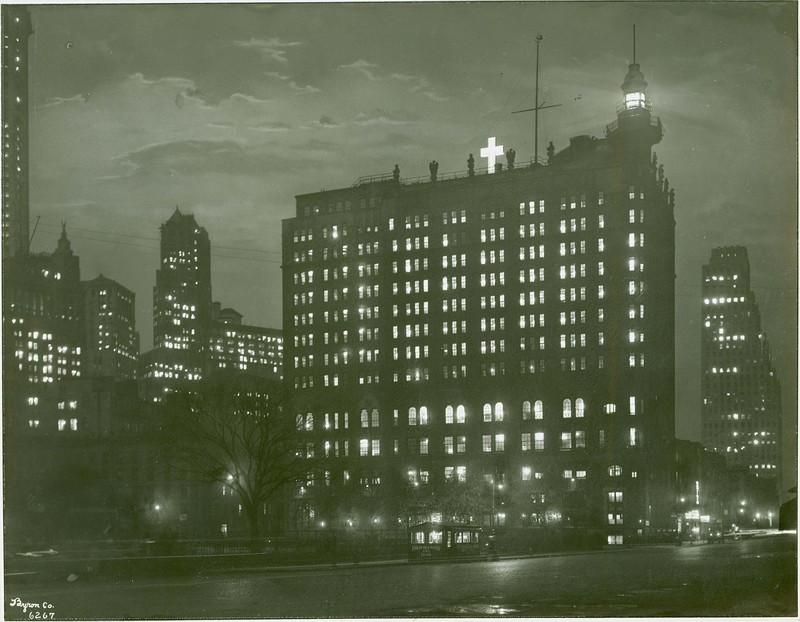
Titanic Memorial Lighthouse, ca. 1920. Courtesy of the Seamen’s Church Institute Archives.
The original Titanic Lighthouse Tower and Time Ball on the roof of the Seamen’s Church Institute (SCI) building included three Cooper Hewitt lamps of 2,500 candle power each. The building committee was (understandably) anxious to have a light that would be as distinctive as possible, and visible all over New York Harbor, down to Sandy Hook and even through the Narrows. So, somehow, green was selected as the color of the lights! “It was necessary to ask permission of the authority at Washington before this announcement could be made but they have now replied that they will allow a fixed green light to be shown from the new Institute tower.”[6]The Lookout, Volume II, Number 12, April, 1912, p. 4.
The 1912 article from The Lookout magazine continues by wondering if sailors would notice the light while sailing up the Harbor, with a reassurance statement by another seamen who was sure it would be recognized. “Oh, that is the Seamen’s Institute where you can go and feel like you’d really come home.”
The Lighthouse Tower was conceived to symbolize to every person entering New York Harbor the spirit of reverence and the appreciation of heroism and self-sacrifice, which prompted the ideation and construction of the Memorial in the first place. “Sensational tales of harrowing accidents crowd each other for space in the newspapers, and, little by little, the average person becomes hardened and callous to stories of sudden death with the consequent bereavement of those who must live and mourn. […] The Lighthouse Tower and Time Ball will make all thoughtful persons realize afresh that the “Titanic” spirit did not die with the ship, and it will make all careless people pause long enough to think —where they never thought before.”[7]The Lookout, Volume III, Number 4, August 1912, p. 3.
I recently talked with Kurt Hirschberg, Associate Partner from Jan Hird Pokorny Associates, to learn more about the plans for restoring and re-activating the lighting system of the artifact. Below is a transcript of this conversation, the third in a series focused on the Titanic Memorial Lighthouse restoration.
Martina Caruso (MC): In the previous blog post we established the fact that the Titanic Memorial Tower never had Fresnel lens, but three really bright green lights. Do we know what type of electricity was available in 1912 in Lower Manhattan, and the SCI’s location at 25 South Street?
Kurt Hirschberg (KH): The three Cooper Hewitt Fixtures installed in the lantern operated at 200–250 Volts DC. Power supplied to the SCI building would have been 110V DC, so each fixture within the lantern had its own wire-wound transformer, which stepped up the voltage to the necessary 200–250 Volts. What is interesting is that each fixture was rated at 35 amps. The average house at that time had a total amperage draw of around 7–15!
MC: And specifically, what is arc electricity compared to Westinghouse’s DC?
KH: “Arc” was a type of lighting system that could be powered with either AC or DC current. Ultimately the power would be converted through transformers to DC to power the electrodes. It is similar in theory to modern day “high-intensity discharge” lamps that are used in most outdoor street lights.
Arc lamps were developed by Charles F. Brush (1849–1929) to provide a significantly brighter and longer-lasting option to a carbon-filament incandescent lamp, which was the standard at the time. The most common arc lamp was carbon arc, which had a pair of carbon electrodes. High voltage “arcing” across electrodes created a bright purplish-white light.
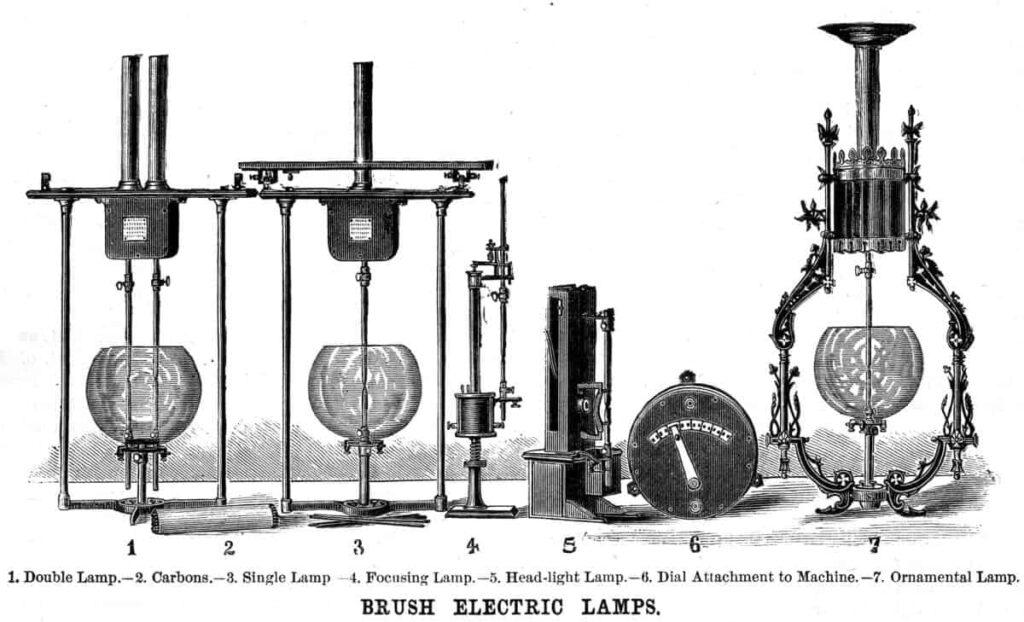
The downside is that the carbon electrodes would break down over time, so there was a good deal of experimentation with combining other metals to create a more durable electrode that wouldn’t require replacement as often. One such product was the mercury arc, which entailed the application of a coating of mercury to help increase longevity, but its downside, for street lighting at least, was an unflattering yellowish-green light created as the carbon and mercury vaporized in the fixture.
MC: Why has the light’s green color been so particular and complicated to figure out today?
KH: When the SCI building at 25 South Street was being built there were two ways to achieve a green light. Either, the use of a colored glass lens to create the desired hue, or through the use of a light source that could create a green glow. The only commercial option available at the time that could provide the color in the lamp itself was a mercury arc lamp.
Because the color-rendering qualities of mercury arc lighting were deemed less than flattering and the technology related to lighting filaments was rapidly evolving, the mercury arc fixture had a relatively short span of service.
It took some research, but we were able to find two references to the color wavelength of a mercury arc fixture: 546.1nm, 96ff00 RGB color—which converts to modern day RGB, 150, 255, 0, equaling a soft chartreuse green color. While not flattering for street lighting, it matches the description of the light in historic copies of the SCI’s publication, The Lookout.

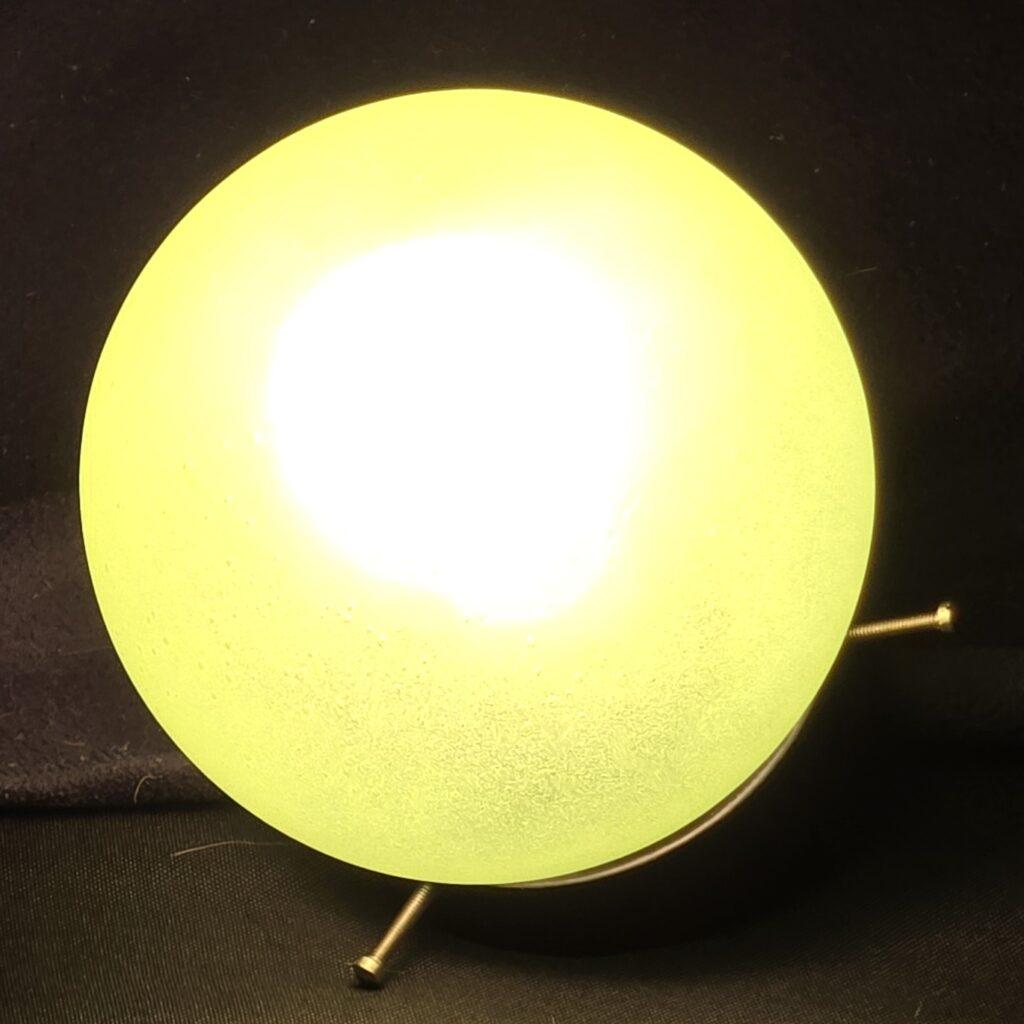
Left: Color sample of the mercury arc fixture
Right: Sample test of a light bulb painted the same chartreuse green color and lighted up.
Here is a video that shows different types of fixtures from the period getting into the mechanics. All the components the presenter shows were at the Memorial.
MC: In the Museum’s collections storage there is a piece of the original lighting mechanism. How meaningful was it to shine some light into this whole affair?
KH: The artifact was extremely meaningful. The fixture, transformers, relays, electrodes, baffle, and the manufacturer’s plate confirmed that the lighting used was indeed “arc” lighting. Historic images in the Museum’s archives as well as the SCI’s archives show the original glass globes were clear, confirming colored glass was not used to create the green color—solidifying that the green colored light was created through the use of mercury within the fixture.
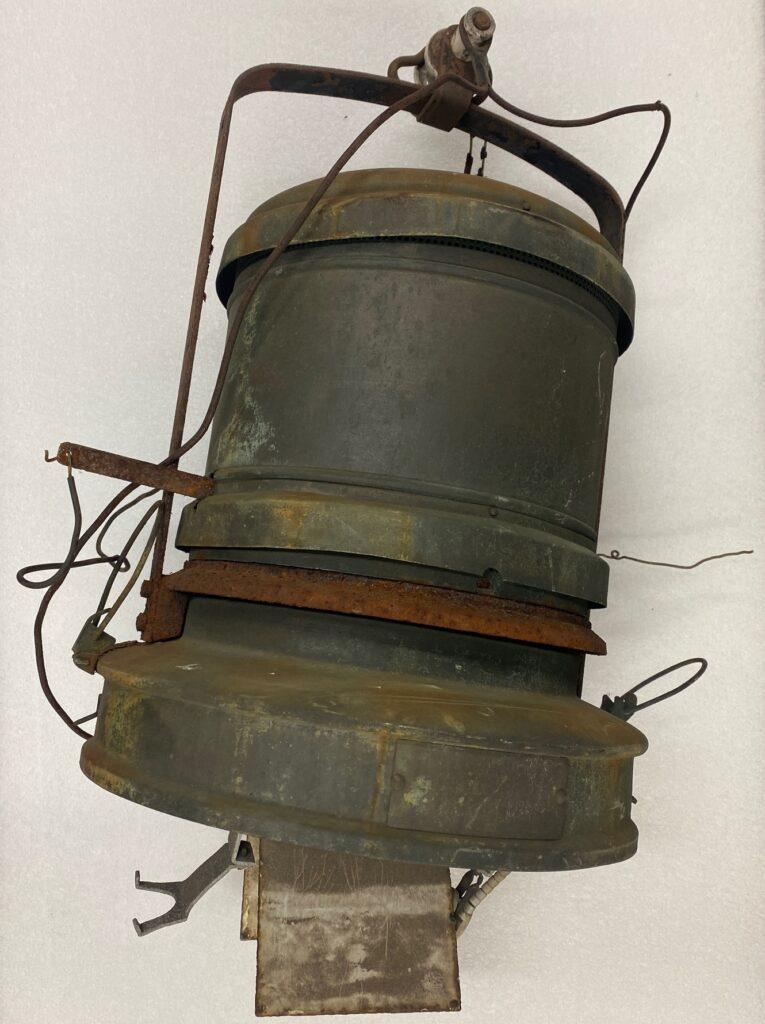

Left: Light fixture preserved in the Museum’s collections storage.
Right: Drawing of the new light fixtures.
MC: Now, let’s talk about these lights! Their shape is fascinating, as well as their final color.
KH: The nature of “arc” lighting creates a good deal of heat at the electrodes. As small portions are continually burned off, dropping fragments could present a fire hazard. The glass globes served three purposes. First, the nature of how the glass was cased provided some magnification of the light. Second, it also provided a means to capture any soldering debris from the electrodes. Lastly, the engineers realized that the more they could “seal” the fixture, the longer the electrode would last. So, a tightly-latched globe would greatly increase the life of the electrodes.
The best way to describe this is to imagine an incandescent light bulb without the glass housing. In simplified terms, that is basically what you had originally.
The weaknesses in these early lighting systems would eventually be addressed as the technology grew into better sealed lamps, allowing better control of metal vapors. The fixtures at the memorial were the forerunners of modern day mercury-vapor and sodium-vapor lights that can be seen in almost every street lamp.
MC: In addition to recreating the historic lighting, the lantern will also feature sensitive accent lighting to spotlight this important artifact and restore it as the beacon it once was. To conclude, let’s talk about the overall lighting for the Titanic Memorial.
KH: The lighting was an integral part of the story of this structure from day one. Reading passages in The Lookout while the design was being finalized and throughout the construction process, they speak of selecting the green light specifically so it wouldn’t be confused with other navigational aids—even going as far as obtaining approval from Washington for the color.
The green light that beckoned tired sailors to the SCI will serve today to draw visitors to the memorial, the South Street Seaport Museum, and the South Street Seaport Historic District as a whole.
Additional reading and resources
“Electric lighting and power distribution. An elementary manual for students preparing for the ordinary grade examinations of the city and guilds of London institute.” 1892. South Street Seaport Museum Rare Book Collection TK145.M45
“The Edison Monthly” Volume IV, February 1912, No. 9. South Street Seaport Museum Archives.
“The Lookout”, February 1912 and August 1912. South Street Seaport Museum Archives.
“Science” by L. H. Baekeland, Vol. 41, No. 1057, April 2, 1915, pp. 484-492.
Model of Edison’s Pearl Street power station, Smithsonian National Museum of American History
“The Monument to Electricity That Never Was” by Matt Novak, Smithsonian Magazine, May 3, 2012.
“EXCELSIOR STEAM POWER COMPANY BUILDING, 33-43 Gold Street, Manhattan” by Landmarks Preservation Commission, December 13, 2016.
“How New York City Gets Its Electricity” by Emily S. Rueb, The New York Times, February 10, 2017.
“Electrifying Manhattan” PBS, American Experience.
References
| ↑1 | Revisit the first and second blog posts in the series at “Shining a Light on a Unique Public Artifact” and “Time Balls“! |
|---|---|
| ↑2 | ”MISCELLANEOUS CITY NEWS; EDISON’S ELECTRIC LIGHT. “THE TIMES” BUILDING ILLUMINATED BY ELECTRICITY.” September 5, 1882, The New York Times. |
| ↑3 | The National Museum of American History owns a scale model of Thomas Edison’s Pearl Street power station, made in 1927. It demonstrates the internal arrangement of generating equipment and can be operated by means of a small electric motor in the base. |
| ↑4 | The remaining unit from the fire is preserved today at the Henry Ford Museum and Greenfield Village, and was designated a National Historic Mechanical Engineering landmark by the American Society of Mechanical Engineers in 1980. |
| ↑5 | Learn About George Westinghouse, Inside an American Factory: Films of the Westinghouse Works, 1904, Library of Congress. |
| ↑6 | The Lookout, Volume II, Number 12, April, 1912, p. 4. |
| ↑7 | The Lookout, Volume III, Number 4, August 1912, p. 3. |

